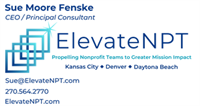
Nonprofit News
Stay updated on the latest news in Kansas City's nonprofit community.
Does your organization have good news to share? Nonprofit Connect is pleased to share news from our members on our website. Post your recent hiring announcements, fundraising achievements, honors and awards, or other good news. Log in to post your news.
Please post event announcements on our free Community Events Calendar.
Why Nonprofit Boards Fail - And How to Fix It
At ElevateNPT, we often hear about nonprofits struggling with ineffective boards. Why does this happen, even with the best intentions? Why does it matter? Because ineffective boards create underperforming organizations.
The most common reasons boards fall short are:
1. Inadequate Attention to Recruitment and Succession Planning
Boards often recruit people without a strong connection to the mission, which leads to weak leadership and disengagement. Without intentional succession planning, boards lose institutional knowledge and momentum, limiting their ability to lead strategically.
2. Weak Board Leadership
When the board chair fails to run effective meetings, model accountability, or partner with the executive director, the board loses focus and members disengage. Poor leadership at the top results in weak oversight and ineffective decision-making.
3. Lack of Fiduciary Awareness
Board members must uphold their duties of care, loyalty, and obedience—ignorance is no excuse. Passive or negligent behavior can be as damaging as poor decisions, and D&O insurance does not protect against neglect of these fundamental responsibilities.
4. Refusal to Embrace Fund Development
Boards that avoid fundraising miss their responsibility to create a culture of philanthropy. Members should act as ambassadors—opening doors, connecting networks, and modeling giving—to sustain the organization and advance its mission.
5. Lack of Diversity
Boards that lack diversity of perspectives, experiences, and demographics risk blind spots and poor decision-making. Diverse boards better reflect their communities, build credibility with funders, and create more equitable, effective solutions.
6. Micromanagement or Lack of Oversight
Sometimes, boards get bogged down in day-to-day management, while others fail to provide needed accountability. The healthiest boards strike a balance, focusing on strategy and oversight while leaving operations to staff.
7. Failure to Wear the Right Hat
Board members often blur the lines between governance and volunteering, undermining staff authority and creating confusion. Recognizing the distinction between policymaking and volunteer work is essential to maintain credibility and effectiveness.
8. Fear of Giving Honest Feedback
Avoiding tough conversations allows dysfunction and misconduct to persist. Healthy boards engage in candid, respectful dialogue to hold each other accountable and make decisions in the organization’s best interest.
9. Inability to Support Consensus
Once a board makes a decision, all members must support it publicly to maintain unity and credibility. Undermining consensus damages trust, confuses stakeholders, and weakens governance.
Learn more in the recent blog post at www.ElevateNPT.com .
Strong boards drive extraordinary community impact. We can build yours together. Let’s chat!
ElevateNPT
-
Sue More Fenske CEO-Principal Consultant
- August 21, 2025
- (270) 564-2770
- Send Email


